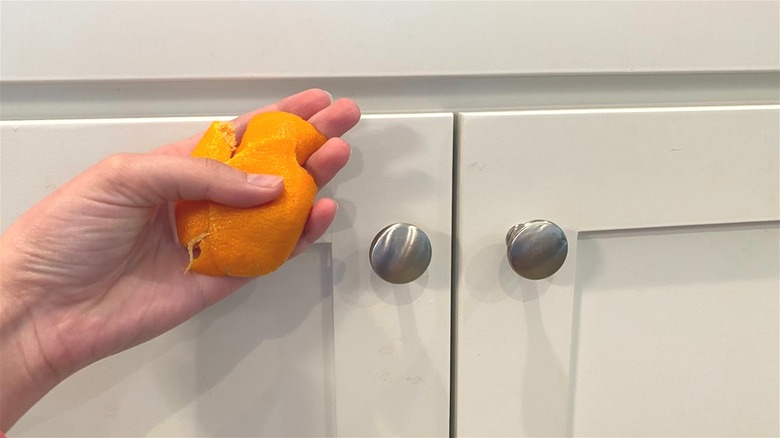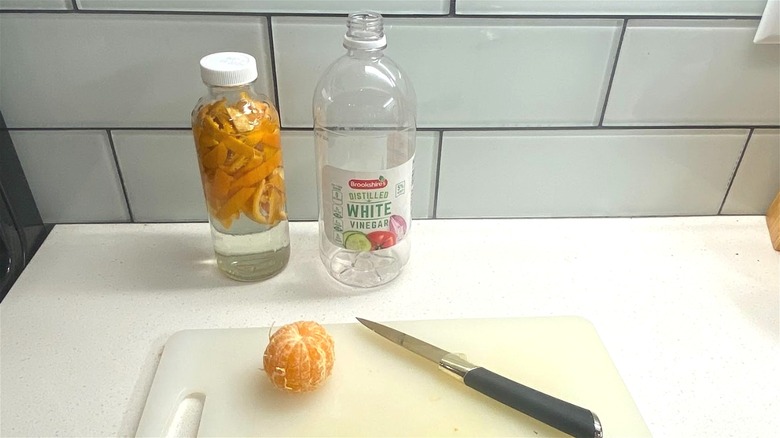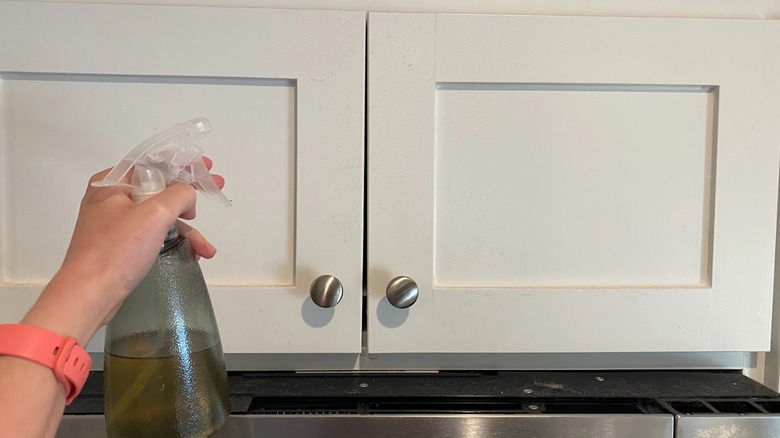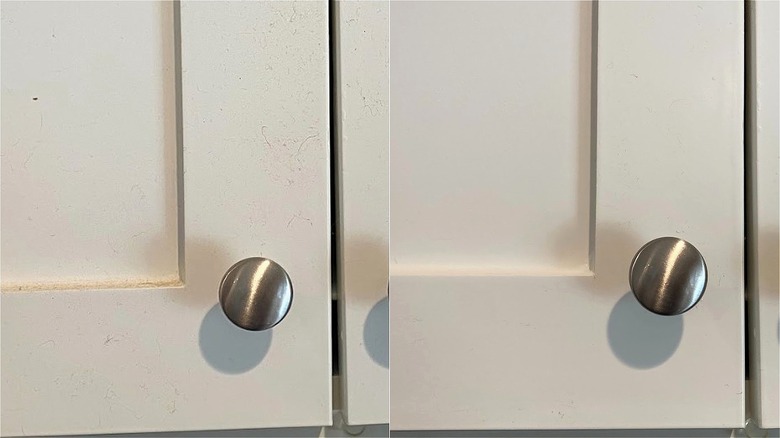We Tried The Orange Peel Hack To Clean Grease Off Our Cabinets. Was It A Fresh Solution?
We may receive a commission on purchases made from links.
No matter how hard you try to keep your kitchen clean, if you do any stovetop cooking, airborne grease is bound to accumulate on your kitchen cabinets. This grease can be surprisingly tricky to remove, especially if it collects for weeks or months and dust builds up in layers. It's especially common to see this grease build-up on the cabinets above your stove and microwave, where it likely isn't cleaned often. Ventilating the kitchen or using a lid over stovetop pans can help to reduce some of this grease, but there will come a day when it's just time to give the cabinets a good cleanse. Luckily, a popular internet hack suggests that combining vinegar and orange peels can extract d-limonene, an ingredient that can help clean up grease splatters in the kitchen.
In my kitchen, grease tends to collect right above the oven and microwave, especially on the bottom ledge of my shaker-style cabinets. I've tried your standard cleaners and multi-purpose sprays, but none seem to fully cut through the grease or keep it from returning, so I was excited to give this simple and affordable hack a try! Here's how I concocted my own cabinet cleaner from orange peels and the surprisingly fresh results that followed.
Mixing up our DIY solution
To brew my cleaning concoction, I gathered four orange peels, a bottle of distilled white vinegar, and an old container — I used an old glass kombucha bottle, thoroughly rinsed. If you were to buy supplies, a bottle of distilled white vinegar costs about $0.12 per ounce on Amazon, of which I used about 8 ounces, so $0.96 worth. A three-pack of plastic spray bottles is listed for under $9.00 on Amazon, roughly $3.00 each. I would consider the kombucha bottle and orange peels to be "free" since they'd normally be discarded. This brings the grand total of our spray and bottle to a whopping $3.96, or only $0.96 to make the spray itself.
First, I cut the four orange peels into thin strips so they could fit through the bottle opening. I poured in enough white vinegar to completely submerge the orange peels and screwed on the bottle lid, then let the concoction sit on the counter for two weeks, giving it a light shake on occasion. When the two weeks were up, my orange peels looked a little gray and faded, but the bottle seemed perfectly sterile! I opened it up and was surprised to find that the smell wasn't nearly as strong as one might think, just light vinegar with a twist of orange! I poured the yellowish liquid through a mesh sieve and into my plastic spray bottle so it was ready to test on the greasy cabinets.
Testing the orange spray
The resulting color of the cleaning liquid was a light yellow-orange, but because I have white cabinets, I wanted to be sure it wouldn't stain. Before diving right into my greasy cabinets, I performed a spot test with the orange spray on the inside of a lower cabinet door. I gave the door a couple of sprays and allowed the liquid to sit for about ten seconds before wiping it away. Luckily, I didn't notice any discoloration, streaking, or staining, so this orange spray passed the spot test!
To see how well the spray would really work, I tackled my greasiest cabinets first — the ones just above the microwave and stovetop. I gave each cabinet door a generous misting with the orange spray, let it work for a few seconds, and then wiped up the spray with a paper towel. After checking the cleanliness after the initial spray, I followed up with a second spray and wipe. I wanted to see if the spray could also remove tough grease stains from my range hood, microwave, and stovetop, so I tested those out after wiping the cabinets.
This sweet hack left my kitchen shining
I was stunned by the before and after photos of this hack! Dust and grease were so thick on these cabinets above the microwave that I wasn't sure anything would work — but the orange peel spray was like magic! After one spray and wipe, I could immediately tell that the grease was lifting, and with a second spray and wipe the cabinets looked and felt good as new. The spray didn't stain my white cabinets, but I'd still recommend doing a spot test inside a door to ensure they'll react well for you. This orange spray hack also delivered great results on other greasy surfaces like my microwave and stovetop!
It's hard to say whether the d-limonene extracted from orange peels or the white vinegar had most of the grease-fighting power. Either way, I think this is a clever way to use orange peels in your home. Because the liquid doesn't contain any harmful chemicals, I'd feel much better about using it to clean the stove and microwave than typical chemical sprays, the residue of which could release toxins into food later. The orange peel spray didn't have a very strong scent, and the white vinegar was completely undetectable once dried, so I would use this spray again as is. However, you could probably add other citrus fruits or a few drops of your favorite essential oil to kick the scent up a notch.



